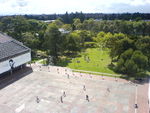Collaborative Design Planting Design Working Group 21: Difference between revisions
| Line 83: | Line 83: | ||
<gallery caption="Image Gallery" widths="150px" heights="150px" perrow="4"> | <gallery caption="Image Gallery" widths="150px" heights="150px" perrow="4"> | ||
Image:Plazache.JPG|Plaza Che | Image:Plazache.JPG|Plaza Che (wikipedia) | ||
Image:yourfilename2.jpg|image 2 | Image:yourfilename2.jpg|image 2 | ||
Image:yourfilename3.jpg|image 3 | Image:yourfilename3.jpg|image 3 | ||
Revision as of 02:12, 22 January 2014
---> back to group page working group 21
Please add the title of your case study here, adjust the map coordinates and replace the moa image with a characteristic image of your site
| Name | Universidad Nacional de Colombia | |
| Location | Bogotá | |
| Country | Colombia | |
| Authors | Arlinda Sheqiri - Victoria Solis Pauwels | |

| ||
|
| ||
Landscape and/or urban context of your case
- Biogeography, cultural features, overall character, history and dynamics
The University City of Bogotá (Spanish: Ciudad Universitaria de Bogotá), also known as the White City (Spanish: Ciudad Blanca), is the main campus for the University. It is located in the Teusaquillo locality, northwest of the historical centre. It is also the largest campus in Colombia, with an extension of 1,200,000 m2 (300 acres) and a constructed area of 308,541 m2 (76.242 acres), making it an ample campus with several green areas, open spaces, and pedestrian paths. Among its buildings there are 17 which have been declared national monuments and, as a whole, it is a representation of the last 60 years of architecture in Colombia.
Central square, Bogota's campus
The campus was designed by German architects Fritz Karsen and Leopold Rother, and its construction began in 1935, under the government of Alfonso López Pumarejo. It is organised as an ellipse, divided in five parts, each containing one of the academic divisions and its respective dependencies. The buildings were constructed as prismatic blocks, and painted white, in order to give an austere and clean look.
Some landmarks in the campus are the León de Greiff Auditorium, and the Francisco de Paula Santander Plaza, also known unofficially as the "Central Plaza" or the "Ché Plaza", in honour of Ernesto el Ché Guevara. The campus has its own stadium, where sometimes matches for the national soccer championship are held.
What are the objectives of your design?
Please give a short written argumentation (not more than 150 words). It is ok if you have different or even contradicting objectives within your group. Just make it explicit at the beginning of your process
Analytical drawings
Please add four analytical sketches/drawings (or montages/schemes) of your case. Every group member needs to contribute at least one drawing.
- Analytical Drawings
- Yourfilename1.jpg
analytical drawing 1
- Yourfilename2.jpg
analytical drawing 2
- Yourfilename3.jpg
analytical drawing 3
- Yourfilename4.jpg
analytical drawing 4
Projective drawings
Please add four projective sketches/drawings (or montages/schemes), of course with an emphasis on planting design/vegetation aspects. Every group member needs to contribute at least one drawing representing his/her individual ideas.
- Projective Drawings
- Yourfilename1.jpg
projective drawing 1
- Yourfilename2.jpg
projective drawing 2
- Yourfilename3.jpg
projective drawing 3
- Yourfilename4.jpg
projective drawing 4
Design Synthesis
Please analyse the individual approaches presented so far and evaluate their strengths and weaknesses (you may use the SWOTanalysis model). Try to create a synthesis and represent it with a plan and some sketches. You can still use drawings/sketches.
- Design Synthesis Drawings
- Yourfilename1.jpg
synthesis drawing 1
- Yourfilename2.jpg
synthesis drawing 2
- Yourfilename3.jpg
synthesis drawing 3
- Yourfilename4.jpg
synthesis drawing 4
Summary of the collaborative process
Please reflect on your collaborative design process. Which potentials have you encountered? What was most difficult? What does collaborative design mean for you? (approx 150 words).
Image Gallery
You may add a series of images/photos in addition to the sketches/drawings
- Image Gallery
- Yourfilename2.jpg
image 2
- Yourfilename3.jpg
image 3
- Yourfilename4.jpg
image 4
References
http://en.wikipedia.org/wiki/National_University_of_Colombia
Some of the images are from Wikipedia, some of the official webpage (www.unal.edu.co) and some more from a personal archive.
About categories: You can add more categories with this tag: "", add your categories
